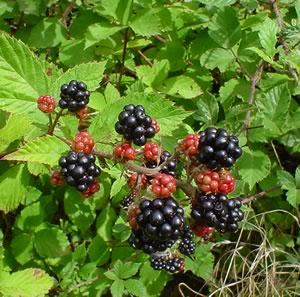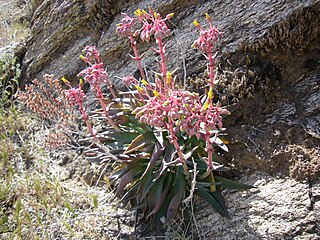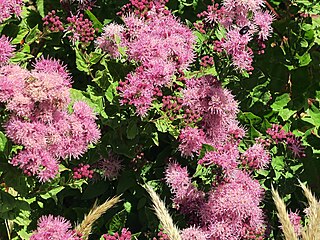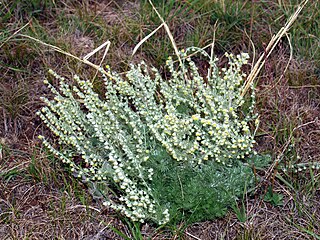
Rubus is a large and diverse genus of flowering plants in the rose family, Rosaceae, subfamily Rosoideae, with over 1,350 species.

Tetrapanax papyrifer, the rice-paper plant, is an evergreen shrub in the family Araliaceae, the sole species in the genus Tetrapanax. The specific epithet is frequently misspelled as "papyriferum", "papyriferus", or "papyrifera". It is endemic to Taiwan, but widely cultivated in East Asia and sometimes in other tropical regions as well. The species was once included in the genus Fatsia as Fatsia papyrifera.

Filipendula is a genus of 12 species of perennial herbaceous flowering plants in the family Rosaceae, native to the temperate regions of the Northern Hemisphere. Well-known species include meadowsweet and dropwort, both native to Europe, and queen-of-the-forest and queen-of-the-prairie, native to North America.

Corallorhiza maculata, or spotted coralroot, is a North American coralroot orchid. It has three varieties: C. maculata var. occidentalis, C. maculata var. maculata, and C. maculata var. mexicana. It is widespread through Mexico, Guatemala, Canada, St. Pierre & Miquelon, and much of the western and northern United States. It grows mostly in montane woodlands.

Hamamelis virginiana, known as witch-hazel, common witch-hazel, and American witch-hazel, is a species of flowering shrub native to eastern North America, from Nova Scotia west to Minnesota, and south to central Florida to eastern Texas.

Anaphalis margaritacea, commonly known as the western pearly everlasting or pearly everlasting, is an Asian and North American species of flowering perennial plant in the family Asteraceae.

Hamamelis vernalis, the Ozark witchhazel is a species of flowering plant in the witch-hazel family Hamamelidaceae, native to the Ozark Plateau in central North America, in Missouri, Oklahoma, and Arkansas. It is a large deciduous shrub growing to 4 m (13 ft) tall.

Eupatorium altissimum, the tall thoroughwort, is a perennial plant whose native range includes much of the eastern and central United States and Canada (Ontario south to Nebraska, eastern Texas, the Florida Panhandle, and Massachusetts. It almost always grows on limestone soils, as does Brickellia eupatorioides, with which it is often confused. It can hybridize with Eupatorium serotinum.

Erigeron annuus, the annual fleabane, daisy fleabane, or eastern daisy fleabane, is a species of herbaceous, annual or biennial flowering plant in the family Asteraceae.

Dudleya saxosa is a perennial succulent plant species in the family Crassulaceae, within the genus Dudleya, which are commonly known as liveforevers. This species is a complex of 3 subspecies of plants, isolated and disjunct in distribution from one another, each with varying levels of ploidy and morphology. One plant is native throughout the deserts and mountains of Southern California, another is found in the Panamint Mountains, and one is found throughout central Arizona.

Corylus americana, the American hazelnut or American hazel, is a species of deciduous shrub in the genus Corylus, native to the eastern and central United States and extreme southern parts of eastern and central Canada.

Artemisia campestris is a common and widespread species of plants in the sunflower family, Asteraceae. It is native to a wide region of Eurasia and North America. Common names include field wormwood, beach wormwood, northern wormwood, Breckland wormwood, boreal wormwood, Canadian wormwood, field sagewort and field mugwort.

Ageratina occidentalis is a species of flowering plant in the family Asteraceae known by the common name western snakeroot or western eupatorium. It is native to the western United States where it grows in several types of habitat. It is found in California, Oregon, Washington, Idaho, Montana, Nevada, and Utah.

Eremalche exilis is a species of flowering plant in the mallow family known as white mallow or desert mallow. It is native to Baja California, Mexico and the southwestern United States where it grows in desert and other dry scrub habitats.

Helianthus occidentalis, the fewleaf sunflower or western sunflower, is a species of sunflower native to the Eastern and Central United States. It grows mostly in the Great Lakes Region and in the Ozarks, with additional populations scattered as far as Massachusetts, Texas, and the Florida Panhandle.

Artemisia frigida is a widespread species of flowering plant in the aster family, which is known as the sunflower family. It is native to Europe, Asia, and much of North America. In parts of the north-central and northeastern United States it is an introduced species.

Allenrolfea is a genus of shrubs in the family Amaranthaceae. The genus was named for the English botanist Robert Allen Rolfe. There are three species, ranging from North America to South America.

Carex blanda, the common woodland sedge or eastern woodland sedge, is a sedge native to a wide variety of habitats in the eastern and central United States and Canada.

Petrorhagia saxifraga, known as tunic flower or coat flower, is a small, herbaceous flowering plant in the family Caryophyllaceae. It is native to parts of Europe and introduced to the United States and Canada, Great Britain, and Sweden. Petrorhagia saxifraga is also known as tunic saxifrage, pink saxifrage, or just pink.
Lysimachia × producta is a hybrid of flowering plants in the primrose family Primulaceae. It is native to eastern North America, from Quebec south to North Carolina, as far west as Wisconsin. The hybrid specific epithet producta means "stretched out, extended", a reference to the shape of its inflorescence. Indeed, the hybrid is sometimes referred to as the elongated loosestrife.



















